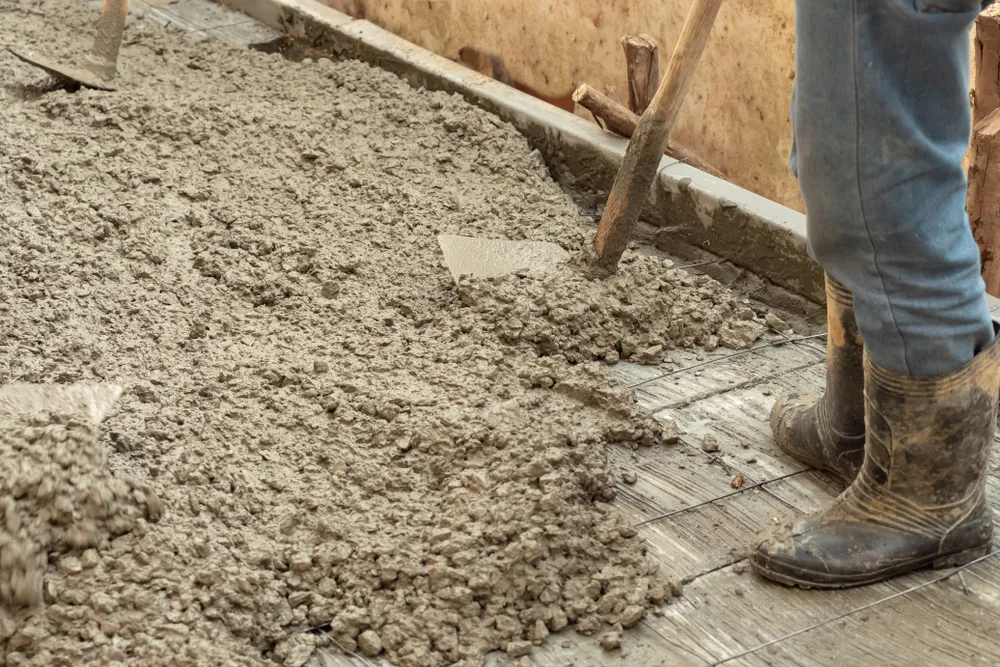Dry pour concrete, often referred to as “dry concrete mix” or “dry mix concrete,” is a versatile and efficient construction material that offers several advantages over traditional wet concrete. In this comprehensive guide, we will delve into the world of dry-pour concrete, exploring its uses, benefits, and strength characteristics and providing step-by-step instructions on how to properly execute a dry-pour concrete project. Whether you’re a seasoned contractor or a DIY enthusiast, understanding dry pour concrete is a valuable skill that can save you time and effort on your next construction endeavor.
What Is Dry Pour Concrete?
Dry pour concrete, also known as “dry mix concrete” or “dry concrete mix,” is a pre-mixed blend of cement, sand, and aggregates. Unlike traditional wet concrete, which arrives at the construction site in a liquid form and requires mixing with water, dry pour concrete comes in a dry, granular state.
This means that all the essential components are already measured and mixed uniformly, eliminating the need for on-site batching and reducing the risk of errors in the mixing process.
The Advantages of Using Dry Pour Concrete
- Consistency: Dry pour concrete offers consistent quality since it is pre-mixed under controlled conditions. This consistency translates into uniform strength and durability across the entire project.
- Reduced Labor: With dry pour concrete, there’s no need for the labor-intensive process of mixing, which is required for wet concrete. This can lead to significant time and cost savings on your construction project.
- Storage: Dry mix concrete can be stored for extended periods without losing quality. This means you can have it on hand whenever you need it, reducing waste and ensuring a readily available supply.
- Less Water Usage: Traditional wet concrete requires a substantial amount of water for mixing, which can be wasteful. Dry pour concrete minimizes water usage, making it an environmentally friendly option.
- Versatility: Dry concrete pour concrete can be used for various applications, including foundations, a dry pour concrete slab, sidewalks, and more. Its versatility makes it suitable for both residential and commercial projects.
Dry Pour Concrete Strength: Is It Reliable?
One common concern with dry pour concrete is its strength compared to wet concrete. The strength of dry-pour concrete is determined by the quality of the mix and the proper execution of the pouring and curing process. When mixed and installed correctly, dry pour concrete can achieve excellent strength properties comparable to wet concrete.
To ensure reliable strength in your dry concrete pour project, follow these key guidelines:
- Use high-quality dry-mix concrete from a reputable supplier.
- Ensure proper compaction during installation to eliminate voids and air pockets.
- Adequately cures the concrete by keeping it moist for the recommended curing period.
By adhering to these practices, you can have confidence in the strength and durability of your dry-pour concrete construction.
How to Dry Pour Concrete: A Step-by-Step Guide
Dry pour concrete may seem straightforward, but it requires precise execution to achieve the desired results. Here’s a step-by-step guide to help you master the art of dry pouring concrete:
Step 1: Preparation
Clear and level the area where you intend to pour the dry mix concrete.
Install any necessary forms or molds to define the shape of the project.
Step 2: Mixing
Purchase high-quality dry mix concrete from a reliable supplier.
Follow the manufacturer’s instructions for mixing, which typically involve adding a precise amount of water to the dry mix.
Use a concrete mixer or mixing equipment to ensure thorough blending.
Step 3: Pouring
Start pouring the mixed dry concrete into the designated area.
Work systematically to prevent inconsistencies in the mixture.
Compact the concrete using a vibrating screed or a tamping tool to remove air voids.
Step 4: Finishing
After compacting, finish the surface with a trowel to achieve a smooth and even appearance.
Consider adding a curing compound or covering the concrete with wet burlap to facilitate proper curing.
Step 5: Curing
Protect the freshly poured concrete from drying out too quickly by covering it with plastic sheeting or wet burlap.
Allow the concrete to cure for the recommended duration to achieve optimal strength.
Step 6: Final Inspection
Once the concrete has cured, inspect the finished project for any imperfections or cracks.
Address any issues promptly to maintain the integrity of the concrete.
FAQs
Is dry-pour concrete suitable for all types of construction projects?
Dry-pour concrete is versatile and can be used for various applications, including foundations, slabs, sidewalks, and more. However, its suitability depends on the specific requirements of your project.
How does dry-pour concrete compare to wet concrete in terms of strength?
When mixed and installed correctly, dry pour concrete can achieve excellent strength properties comparable to wet concrete.
Can I store dry mix concrete for an extended period?
Yes, dry-mixed concrete can be stored for extended periods without losing its quality, making it convenient for construction projects.
Do I need special equipment to work with dry-pour concrete?
While specialized equipment like concrete mixers and vibrating screeds can be helpful, basic tools like a trowel and compaction equipment are typically sufficient for most dry-pour concrete projects.
What is the curing process for dry pour concrete?
Curing involves keeping the freshly poured concrete moist for a specified period to facilitate proper hydration and strength development.
Can dry-pour concrete be used for DIY projects?
Dry-pour concrete can be suitable for DIY projects, but it requires proper preparation and execution. Beginners may benefit from professional guidance.
Conclusion
Dry pour concrete offers a practical and efficient solution for various construction projects. Its advantages, including consistency, reduced labor, and versatility, make it a valuable choice for both contractors and DIY enthusiasts.
By following the recommended guidelines for mixing, pouring, and curing, you can achieve reliable strength and durability with dry pour concrete. Whether you’re building a foundation, a walkway, or a patio, mastering the art of dry-pour concrete opens the door to countless possibilities in the world of construction.

